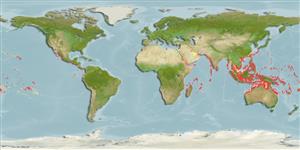>
Anguilliformes (Eels and morays) >
Muraenidae (Moray eels) > Muraeninae
Etymology: Gymnomuraena: Greek, gymnos = naked + Latin, muraena = morey eel (Ref. 45335).
More on author: Shaw.
Environment: milieu / climate zone / depth range / distribution range
Ecología
marino asociado a arrecife; rango de profundidad 3 - 50 m (Ref. 30573). Tropical; 30°N - 24°S, 32°E - 78°W
Indo-Pacific: Red Sea and East Africa (Ref. 33390) and Persian Gulf (Ref. 68964) to the Society Islands, north to the Ryukyu and Hawaiian islands, south to the Great Barrier Reef. Eastern Central Pacific: southern Baja California, Mexico and from Guatemala to northern Colombia, including the Galapagos (Ref. 9324).
Tamaño / Peso / Age
Maturity: Lm ? range ? - ? cm
Max length : 150 cm TL macho / no sexado; (Ref. 1602); common length : 50.0 cm TL macho / no sexado; (Ref. 30573)
Espinas dorsales (total) : 0; Radios blandos dorsales (total) : 0; Espinas anales: 0; Radios blandos anales: 0; Vértebra: 132 - 137. Close set narrow dark bands (Ref. 30404). Has close-set pebble-like teeth used for crushing hard-shelled prey (Ref. 37816). Rounded snout (Ref. 48635).
A secretive inhabitant of sandy and rocky bottoms, crevices and ledges of seaward reefs. It feeds primarily on xanthid crabs, but also on other crustaceans, mollusks and sea urchins (Ref. 9710, 48635). Benthic from 1-39 m, usually at <4 m (Ref. 58302). Possibly a protogynous hermaphrodite (Ref. 32169). Minimum depth reported taken from Ref. 30874.
Life cycle and mating behavior
Madurez | Reproducción | Puesta | Huevos | Fecundidad | Larva
Protogyny unconfirmed (Ref. 84746).
Chen, H.-M., K.-T. Shao and C.T. Chen, 1994. A review of the muraenid eels (Family Muraenidae) from Taiwan with descriptions of twelve new records. Zool. Stud. 33(1):44-64. (Ref. 6934)
IUCN Red List Status (Ref. 130435: Version 2024-1)
Threat to humans
Harmless
Human uses
Pesquerías: escaso valor comercial; Acuario: Comercial
Herramientas
Special reports
Download XML
Fuentes de Internet
Estimates based on models
Preferred temperature (Ref.
123201): 24.7 - 29.1, mean 28 °C (based on 1176 cells).
Phylogenetic diversity index (Ref.
82804): PD
50 = 1.0000 [Uniqueness, from 0.5 = low to 2.0 = high].
Bayesian length-weight: a=0.00049 (0.00024 - 0.00099), b=3.26 (3.10 - 3.42), in cm total length, based on LWR estimates for this (Sub)family-body shape (Ref.
93245).
Nivel trófico (Ref.
69278): 3.8 ±0.33 se; based on food items.
Resiliencia (Ref.
120179): Muy bajo, población duplicada en un tiempo mínimo superior a 14 años (Preliminary K or Fecundity.).
Fishing Vulnerability (Ref.
59153): Very high vulnerability (90 of 100).
Nutrients (Ref.
124155): Calcium = 22.3 [11.4, 34.8] mg/100g; Iron = 0.405 [0.239, 0.854] mg/100g; Protein = 18.6 [16.3, 21.1] %; Omega3 = 0.088 [0.038, 0.242] g/100g; Selenium = 54.4 [28.4, 107.5] μg/100g; VitaminA = 43.1 [11.3, 148.7] μg/100g; Zinc = 0.944 [0.659, 1.328] mg/100g (wet weight);
